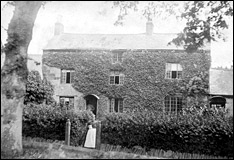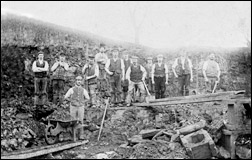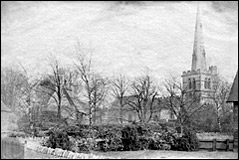The village (as it was then) was chiefly engaged in farming and ironstone mining. The principal farmers were:
Mr.
Harpur
,
Rev
Newman
,
Mr
Attfield
,
Mr
Eady
and
Mr
Barlow
. There was hardly any industry. Whitney & Westley’s started work in a little cottage in
Finedon Street
, opposite to their present factory.
Mr James managed Wallis & Linnell’s factory and also ran a shop where the workers would buy their oil and buttons if short on any garments.
Later six old houses were pulled down in Bakehouse Lane and Hart & Levy’s factory was built; their work used to come by rail.
There were three flour mills on the river Ise – Wallis’s (now the Weetabix), Randalls at Isham (now a ruin) and Robinson’s (burnt out in 1938).
There were many butchers and bakers and grocery shops, and five public houses. The Battle family of Cranford owned a Brewery in Church Street.
Generations of the Blake family had the village smithy and in the winter time horses would be taken there for what was called “turning up”.
Where the Bank and Post office now stand used to be an old thatched house belonging to Becky Warr who kept a shop, and would sell a farthing’s worth of sweets. And there was a selection!!
Water was obtained from the old pumps of Stockwell in Church street, Boultons in Rock Terrace and one in Amblers Yard. People living south of the village had theirs from a spring.
A score of eggs cost 10d. A pound of butter 1/-. Coal 10d a cwt.
There was no resident doctor. Dr. Price of Kettering used to come over twice a week by horse and cart, and used to bring his own groom to hold the horse when he alighted. The first resident Dr was Dr Harris and he lived in the old farm house on the High Street now occupied by Mr. George Mason (Garage), where he had his surgery.
Also there was no dentist; people either went to Kettering or Wellingborough, but a Mrs. Roddis in Church Street sold toothache essence for a penny, take your own bottle.
The main entertainment was Burton Feast when the annual Fair occupied the field on which now stands Pioneer Avenue. There used to be Thurston’s flying horses a 1d a time and Blandies Ghost for 2d, also there was a Boxing booth belonging to Mr. Balls, and local men would be invited to fight the champion. The Fair used to stay a week, and there would be a Band contest on the Saturday. De Mars used to hold plays in the “Park “ as it was then (now occupied by Newman, Spencer and Rosebery Streets). The principle play was “Maria Marten and the Red Barn”. General admission was 2d but if you wanted to sit in the front row it was 4d.
Election times were lively. On Coleman’s Green then stood the Constitutional Hall a large building long since demolished. Meetings were held there. Once when
Col.
Stopford
-
Sackville
of Drayton House was speaking inside, some people tied the two back wheels of his carriage together. When he came out and called to the coachman to start off, the horses reared when the carriage would not budge. Dances would also be held in this public hall and would cost 4d and 6d according to the duration. The only music was provided by Joe White with his concertina. There was always an annual meat tea, with pork pies, etc, followed by a dance, all–in charge at 1/- (one shilling)
What we know as Station Road today was then called Balls Lane and was only a cart track leading to Wallis’s Mill and Isham. One day a woman was crushed to death between the gate at the bottom of the Lane, and a mill wagon. The Lane was not wide enough for two wagons to pass. Apart from six stone houses beyond the Mission room (on the opposite side) Amblers Cottage was the last on the High Street going south. Alexandra Street then only consisted of a little row of houses which stood on a cart track.
There were no proper roads, only muddy tracks and where there were pavements they were cobbled.
The Council School now stands where once was a garden and orchard.
On May Day the children used to get up very early in the morning and go out into the fields and break branches off the trees and make flower garlands. The girls would be dressed in white. They used to sing – “Awake and call me early, call me early mother dear, Tomorrow will be the happiest day of all the glad new year, Of all the glad new year mother, for I am to be Queen of the May, mother, I am to be Queen of the May”
They would go round the village knocking on the doors and singing, and would be given pennies and half-pennies. At a given time they were to go to the Hall, the Rectory and Fern Bank where pennies would be put in their boxes.
Mail was delivered at 7 o’clock in the morning and collected again at 6 o’clock in the evening by horse and cart, when it would then carry on to Cranford. Mr. John Moore ran the Post Office which was then in Church Street.
Most people going to Kettering
if they did not want to walk, went by train and the fare was 2½d single.
There was a murder committed in 1893 when Dick Sabey cut the throat of a local girl. He was brought into Burton in a horse and cart and for a time was kept in the stable yard of the Red Cow Inn, but the unrest and murmuring of the Burtonians gathered in the street hastened his departure to Kettering, from where he was later taken to Northampton, tried and hanged.
Queen Victoria’s Diamond Jubilee in 1897 was celebrated, and in big letters, banners carried the wording “Well played, 60 not out”. Burton was a cricket village and produced many good players.
When the Boer War finished two local lads who returned, Jack Loake and Toddy Dent, were “chaired” round the village. When Queen Victoria died no one went to work – the Church bell tolled all day and there was a service in the afternoon.
Winters in those days used to last about 13 weeks and the summers were very hot. Sometimes the wells used to run dry and services would be held in church to pray for rain.
Women used to go cleaning corn, and they would often carry this in a coarse apron on their heads. Sometimes they would go as far as the Round House.
|


